#Her hair is like 5 blocks below cloud level at her highest point
Explore tagged Tumblr posts
Text

Hey girl. I heard you only have 2 lines of dialogue
Extra photos below!


#Her hair is like 5 blocks below cloud level at her highest point#I spent WAY TOO LONG on her but I love her so much so it was worth it#shes not perfect. some of her colors are off. but I did my best#homestar runner#h*r#marzi-mei#stinkoman#stinkoman 20x6
31 notes
·
View notes
Text
Journal 9 (11/14/18)
Section 1 - Overview
Our final field trip was a short outing to Lovers Key at Fort Myers Beach. Lovers Key is both a beach and a state park. It got its name because when it was first founded, it was only accessible by boat, so young couples would sneak out to the island for a romantic getaway. There are three other keys/islands that surround the area of Lovers Key: Inner Key, Black Island, and Long Key. Lovers Key is a popular location to collect shells because of their abundance along the shoreline.
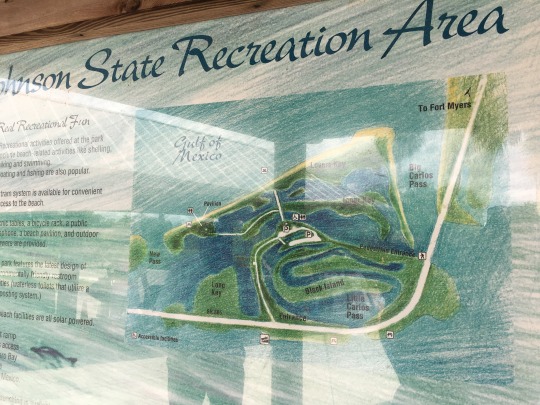
The map of Lovers Key and its surrounding islands.
Section 2 - The Boardwalk
In order to get to the beach at Lovers Key, we had to walk along a boardwalk. The boardwalk was a bridge over the water and it was surrounded by mangrove trees. The naturalist told us about the three main types of mangrove trees in Southwest Florida: red, black, and white. Red mangroves are at low levels and stay close to the water’s edge. Their roots stick out of the ground and grow out towards the water. Their leaves are larger and more pointy compared to the leaves of other mangroves. Black mangroves stay in areas that are slightly highers than red mangroves so that their roots can get air during low tide. Their roots are horizontal. The leaves of black mangroves are opposite of each other and encrusted with salt on the hairy backs. White mangroves live at the highest area, staying away from the water at low tide. They have no visible aerial roots. White mangrove leaves are yellow-green and have small sugar glands at the base. White mangroves also blossom white flowers in the spring. We also learned about propagules, which are mangrove seedpods that remind me of string beans. The mangroves release the seedpods into the water, where it must stay for a certain period of time. Once the propagule was found a favorable area, it will attach and begin to grow roots. The naturalist taught us a rhyme to remember the difference between the mangrove trees:
Red, red, point head Black, black, lick the back White, white, goes on tight
As we continued along the boardwalk, the naturalist told us about estuary systems. Lovers Key is an estuary, which is where a river and the ocean meet. Estuaries have brackish water, meaning it is a mixture between salt and fresh water. These types of systems are popular breeding grounds to many different species of fish, birds, plants, and other marine life. The naturalist also took a moment to discuss red tide with us. She explained that it is a harmful development of algae that produces toxins that kill sea life and cause dangerous circumstances for both nature and humans. Red tide infects many fish and other marine animals, which in turn cause the animals that eat the fish to become sick as well. This causes a strain on the marine industry, since it is unsafe to eat fish infected with red tide. Also, red tide emits harmful toxins into the air, which is dangerous for marine life and humans. There are many misconceptions to the causes of red tide. Many people believe that it is a man-made phenomenon caused by pollution. However, red tide is a naturally occurring affect that happens almost every year during the summer. However, what’s different about this year is that we haven’t seen red tide this intense and close to shore. The reasoning behind this could be the unenvironmentally friendly habits of humans. Hopefully we will learn a lesson from this experience about taking care of our ecosystems.
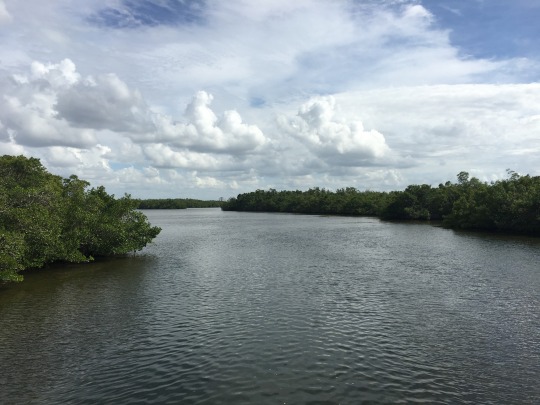
The view upon walking across the boardwalk.

I was amazed by how clear the water was as we walked along the boardwalk. You could see right to the bottom! The beaches where I’m from on the east coast of Florida are never have water this clear; it’s usually cloudy and rough.
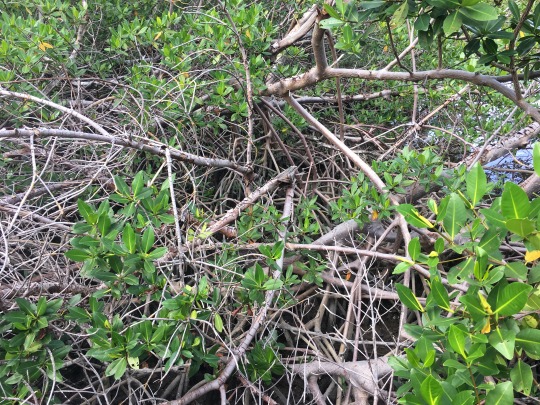
The roots of a red mangrove tree. They have prop roots, which means they stick out above the ground.

These are the leaves of a red mangrove tree. They are long and pointy; the front and back is smooth and shiny.

Another view of the mangrove trees as we got closer to the beach.
Section 3 - The Beach
I very much enjoyed our short walk along the beach. The air was cool and it wasn’t humid like usual. The sun was blocked by dark clouds, so it wasn’t hot at all. The wind was strong but I enjoyed the sea salt air as it blew through my hair. The sand felt nice on my toes and we fell behind the rest of the group as we searched for shells. I love going to the beach, so I genuinely had fun during this field trip. As we collected shells, we ran into an older woman who was also looking for shells too. She taught us how to safely store a sand dollar, since they are very fragile. She packed sand into a larger shell, placed the sand dollar into the middle, and gently cover it with more sand. We continued to chat with her and discovered that her and her husband were from Oregon and they were here on vacation. We told her that we were students on a field trip and briefly discussed the issues with the environment of Southwest Florida. After we said goodbye, I thought about all the interesting people that come to visit Florida for its beautiful beaches. I hoped that she felt inspired by our knowledge about environmental issues.

Our initial view and the first photo I took upon walking on the beach at Lovers Key.

The dark clouds covered the sun, which made the weather perfect. The light still reflected off of the water. The waves were crashing and the tide was a bit rough, but the sound of the waves was relaxing.

Another beautiful view of the beach. I didn’t noticed until I went home and looked back at the photos I took that somebody wrote “Lovers Key” in the sand.

A view of the water as we got closer to where the waves were crashing.

An overall view of the shells that covered the sand. I was amazed by how many shells were along the beach and I wondered how many there were and where they have all been.
Section 4 - Shell Identification
I found many interesting shells as we walked along the beach at Lovers Key. I picked these ten shells for my identification because I thought that they were the most unique. I have seen shells similar to these before, since I grew up visiting the beach often as a child. However, I never learned their names or anything about them. I took this opportunity to educate myself of the shells that I recognize from my childhood.

1. Sand Dollar - A sand dollar is a type of sea urchin that feeds on plankton and other organic materials. A live sand dollar is brown in color and is covered in tiny hairs. When they die, they turn white, like the piece shown above.

2. Broad Ribbed Cardita - These types of shells have radiating ribs that poke out and are usually scaley. The ribs have spots on them and cross to create bands. These shells are usually either purple or reddish-brown. Sea snails usually feed on broad ribbed carditas and their halves can be found on the west coast of Florida.

3. Cockle - The two halves of a cockle shell are symmetrical and they have evenly spaced ribs. They are able to shut completely with no space between. They usually live in buried sediment and are able to “jump” with their foot.
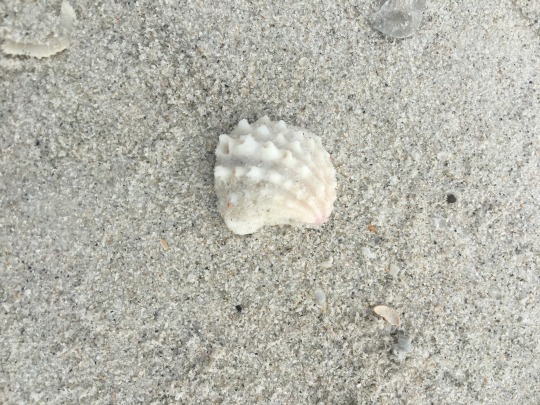
4. Spiny Jewel Box - These shells get their name from their shape; they look like little containers. The spines of this shell are very long while living in the water, but they quickly wear down once they reach the surface. They live on rocks and other rubble of the beach.

5. Scallop - Scallops are a type of sea mollusk that live on the ocean floor. They are able to move around by quickly clapping their shells open and closed. This allows them to migrate or escape from predators, like starfish. Scallops also have a ring of eyes around the tops of their shells. Their shells come in many bright colors, like purple, red, and yellow.
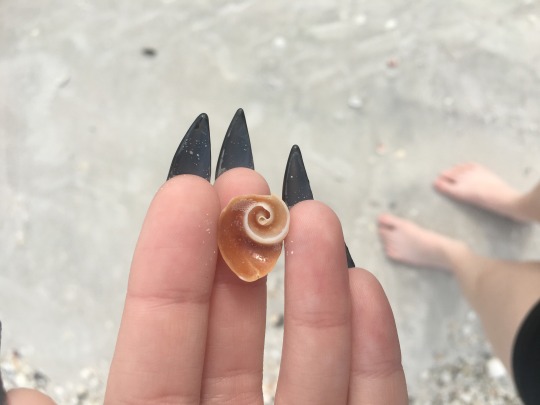
6. Shark’s Eye - This is the bottom of the shell, which gets its name from its appearance, which resembles a shark eye. A Shark’s Eye is a predatory sea snail; it digs through the sand for claims and other small shells. They eat their prey by drilling a hole through the shell and scrape out the meat. The snails live just below the shoreline and their empty shells are commonly found on the shore.

7. Florida Fighting Conch - This is the shell of a sea snail called the Florida Fighting Conch. The curved edges of the shell allow the eyes to look out from under the shell. There are typically nodules along the top of the shells. Florida Fighting Conchs use their feet to crawl and scare of enemies. They also live in shallow and warm water.
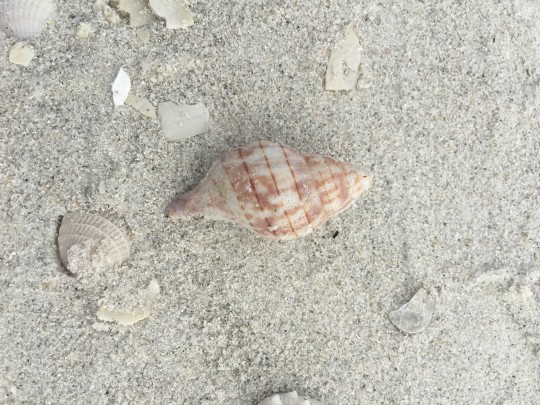
8. Banded Tulip - The banded tulip is a type of sea mollusk that lives off of a carnivorous diet. They are known to eat other conchs, shells, and even clams. They have “toothed” tongues that they use to dig a hole through the shell of their prey and they scoop out meat. Banded tulips are one of the most aggressive species of shells in Florida.

9. Lightning Whelk - This mollusc is a predator of the ocean. They feed on clams, oysters, scallops, and other shells. They have a foot that they use to pry open shells and suck the meat out with a tube-like tongue. Unlike most whelks and shells, their spiral curves to the left.

10. Buttercup - The buttercup has a smooth surface on the outside. They live in shallow waters and burrow beneath the sand. They filter feed and draw water in from a cavity on the surface. They are a popular prey of fish, crabs, and birds.
Section 5 - Black Island
The second half of our field trip continued on to Black Island, which is one of the islands that surrounds Lovers Key. The naturalist told us that Black Island is named after a pirate called Black Augustus, who sailed into hiding from American forces in the 1800s. He was a fugitive and hid his treasures on the island; he lived there for the rest of his life. The island is surrounded by additional estuary systems and mangrove trees. The naturalist told us that some of the most prominent species on the island are gopher tortoises. These animals dig deep burrows in the ground that were described as “condominiums”. Their burrows are underground tunnels that are connected by several “rooms”. many other species use gopher tortoises’ burrows as shelter as well, which is a perfect example of the biodiversity of Black Island. Without these tortoises, many animals would lose their homes. Gopher tortoise burrows are also useful during forest fires. During an emergency, animals can flee into the burrows, which are deep enough to protect them from the fires. Black Island is also home to many species of butterflies. There is a butterfly garden on the island, where butterflies are bred and released into the wild to increase the population. Although we only stayed on the island for a brief amount of time, I learned a lot about the history of Southwest Florida and the importance of keeping species safe.

The view on the nature trial as we walked through Black Island.

Black Island was covered with many different types of mangrove trees.
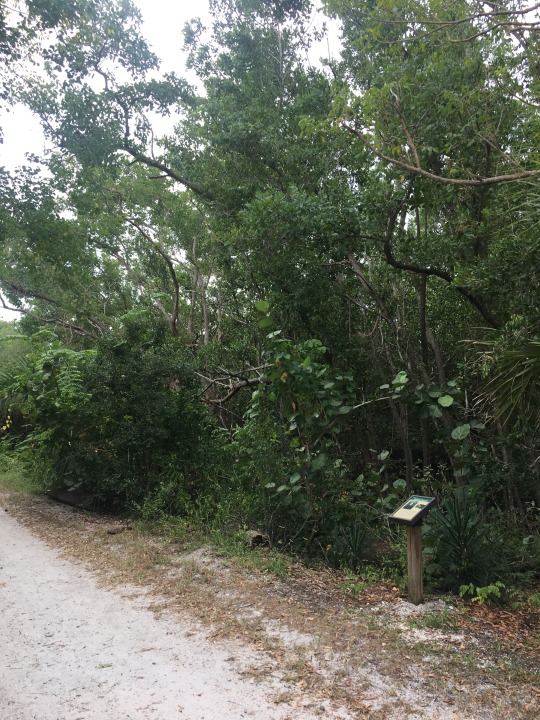
Additional vegetation along the nature trial.

The nature trial split off into many sections, although we only went down one path.

The view from the lookout point on Black Island where we stopped to reflect.

Information on the many butterfly species in Black Island and Lee County.

This was the center in the butterfly garden where butterflies are bred and released to increase the population. The small plants are used for the butterfly cocoons to develop. The butterfly in the top of the enclosure has recently escaped the cocoon.
Section 6 - Additional Photos of Interest
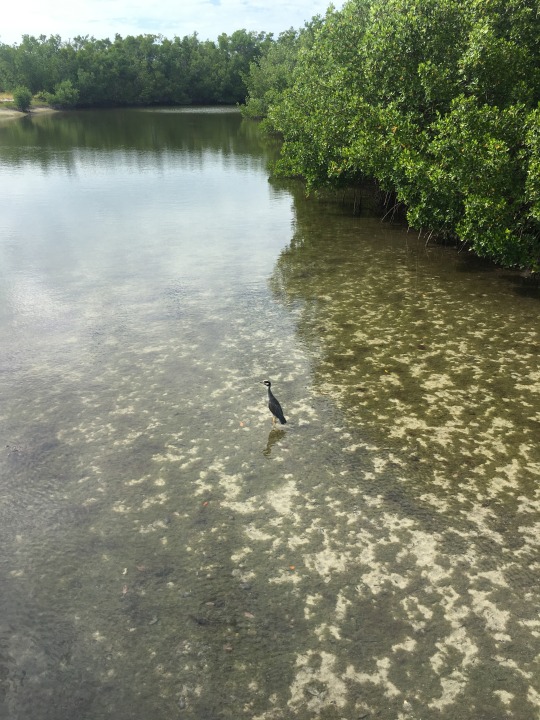
A bird in the estuary system of the boardwalk. This is the perfect ecosystem for marine life, due to its qualities for breeding and feeding grounds. The mangrove trees provide shelter and food for animals like this bird.
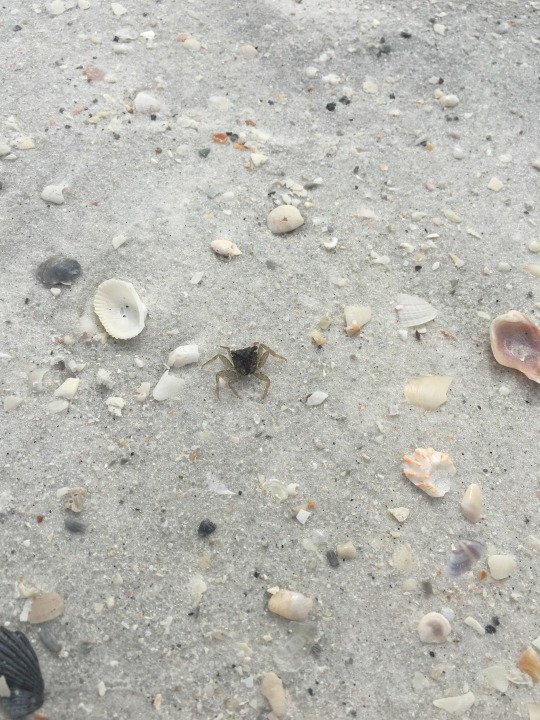
A tiny crab that we found scurrying across the sand as we were searching for shells.
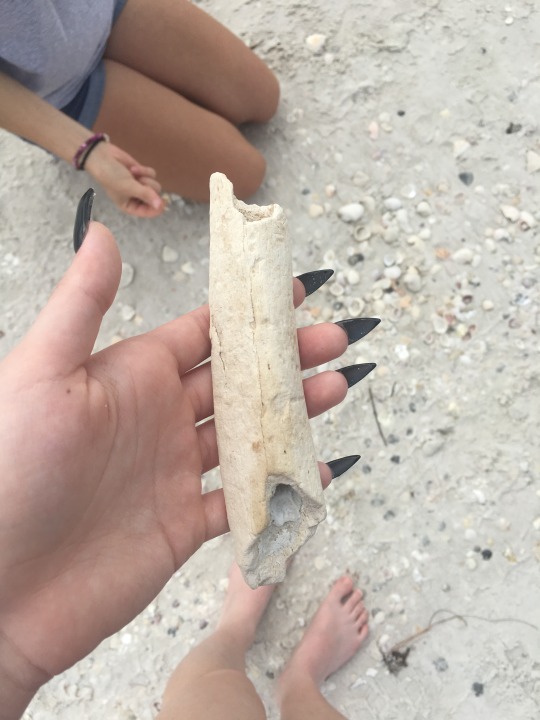
As we were looking for shells, Nicole found a object that closely resembles a bone. We studied the item by tapping it, looking inside and along the edges, and even smelling it. We asked a few other classmates what they thought it was and we got mixed responses; some said it could be a bone while others felt like it was a bleached piece of driftwood. I took the object with me and showed it to my forensic anthropology professor the following week. She is specialized in osteology and I knew that she would be able to tell if it was a bone. She informed me that this object looks very much like a bone, but she would be able to tell for sure if it were sawed in half in order to see the deposits of bone marrow. We both determined that it definitely is too large to be a human bone, so it must be from a sea animal. We could also tell that it was extremely weathered from wind, sand, and water. My professor also gave me an extra credit opportunity if I was able to do research and determine if this is in fact a bone and what kind of bone it is. I still have it with me and I hope to look into it when I have the time.
0 notes